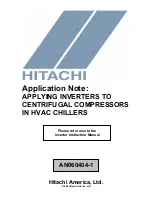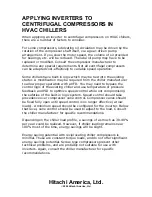
Hitachi America, Ltd.
©
2004 Hitachi America, Ltd.
APPLYING INVERTERS TO
CENTRIFUGAL COMPRESSORS IN
HVAC CHILLERS
When applying an inverter to centrifugal compressors on HVAC chillers,
there are a number of factors to consider.
For some compressors, lubricating oil circulation may be driven by the
rotation of the compressor shaft itself, via a gear-driven pump
arrangement. If you slow the motor speed, the volume of oil provided
for bearings, etc. will be reduced. The lube oil pump may have to be
replaced or modified. Consult the compressor manufacturer to
determine any special requirements. Not all centrifugal compressors
can be adapted cost-effectively to variable speed operation.
Some chillers have built-in logic which may be tied into the existing
starter. A modification may be required from the chiller manufacturer
to allow proper operation with a VFD. You may need to bypass the
control logic of the existing chiller and use temperature or pressure
feedback and PID to optimize speed control while not compromising
the safeties of the built-in logic system. Speed control should take
precedence over compressor vane control. Compressor vanes should
be fixed fully open until speed control is no longer effective (at low
loads). A minimum speed should be configured for the inverter. Below
that level, vane control should be used to adjust to the load. Consult
the chiller manufacturer for specific recommendations.
Depending on the chiller load profile, a savings of as much as 30-40%
per year could be realized. However, if chiller loading remains near
100% most of the time, energy savings will be slight.
Energy saving potential with reciprocating chiller compressors is
minimal. These are constant torque loads, and do not offer significant
energy savings potential. Screw-type compressors present other
technical problems, and are probably not suitable for use with
inverters. Again, consult the chiller manufacturer for specific
recommendations.




















